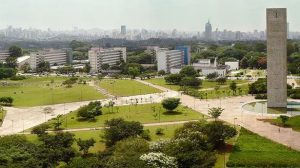
UNIVERSITY OF SÃO PAULO
UNIVERSITY OF SÃO PAULO
PAMinSA VIII will take place on the main campus of the University of São Paulo (USP), located in São Paulo city. The University of São Paulo was founded in 1934 and today is the largest and best university in Brazil. In addition, it is ranked among the top five international universities in Latin America.
USP has 54 units dedicated to teaching and research, including institutes, colleges and museums, as well as 70 libraries, 4 hospitals and 2 veterinary hospitals, distributed in 8 campuses located in several cities in the State of São Paulo. There are 183 undergraduate courses in all areas of knowledge and 239 postgraduate programs, totaling more than 96 thousand students enrolled in undergraduate and postgraduate courses.
Currently, USP is responsible for more than 20% of Brazilian scientific production in basic research, applied and advanced technology development, and in all areas of knowledge.
https://www5.usp.br/institucional/escolas-faculdades-e-institutos/
http://www.usp.br/internationaloffice/en/
Museum of Archaeology and Ethnology
The Museum of Archeology and Ethnology of the University of São Paulo (MAE-USP) is an institution dedicated to research, teaching and cultural and scientific diffusion, which in its present structure has existed since 1989.
The MAE-USP collection consists of approximately 1,500,000 items between archaeological and ethnographic objects produced in different continents and at different times, from European Paleolithic artifacts to contemporary artifacts produced by indigenous peoples of Brazil, as well as including an important human osteological collection. The first researches and collections that contributed to its formation go back to the nineteenth century and, since then, this collection is continually expanded as a result of the researches developed by professors, researchers and postgraduate students in several areas, among which stand out: Brazilian Archaeology , Andean Archaeology, Mediterranean Archaeology, America Settlement, Ethnoarchaeology, Bioarchaeology, Geoarchaeology and Coastal Archeology.
MAE-USP also houses the oldest post-graduate program in archaeology in Brazil, a post-graduate program in museology, and a library specialized in archaeology and ethnology with approximately 90,000 volumes among books, catalogs, theses, periodicals and rare books. In addition, MAE-USP offers extension courses and courses for several USP undergraduate courses.
The Human Osteological Collections of the University of São Paulo
The Museum of Archaeology and Ethnology of the University of São Paulo (MAE-USP) houses a large collection of human skeletal remains of archaeological origin, which is made up of more than 300 individuals from various regions of Brazil and other countries. Originally, the collection was part of old institutes of the University of São Paulo that were unified during the foundation of MAE-USP in 1989. The collection includes skulls obtained in the XIX century as well as skeletons from recent research. The human osteological collection of the MAE-USP is one of the five most important human collections of archaeological origin in the country, especially when sambaquis (shellmounds) are considered. The curatorial management of this collection is conducted by the Laboratory of Bioarchaeology under the coordination of Dr. Veronica Wesolowski.
The Institute of Biosciences of the University of São Paulo (IB-USP) also houses important skeletal collections of archaeological origin. We highlight the early Holocene skeletons from the archaeological site of Lapa do Santo at Lagoa Santa region. The material excavated from Lapa do Santo between 2001 and 2009 is housed today in the Laboratory of Human Evolutionary Studies (LEEH-USP), founded by Dr. Walter Neves and currently under the coordination of Dr. Mercedes Okumura. The material excavated from 2011 onward is housed at the Laboratory of Archaeology and Environmental and Evolutionary Anthropology (LAAAE-USP), which is coordinated by Dr. André Strauss (MAE-USP) and Dr. Rui Murrieta (IB-USP). The LAAAE-USP also temporarily houses, under the coordination of Dr. Rodrigo Elias de Oliveira, the middle Holocene skeletal collection from the archaeological site of Caixa D’Água (Buritizeiros).
Finally, the Laboratory of Biological Anthropology (LAB-USP), coordinated by Dr. Sabine Eggers, houses the skeletal series from the Jabuticabeira II shellmound.
In addition to osteological collections of archaeological origin, the University of São Paulo also counts with the ‘Museum of Human Anatomy – Professor Alfonso Bovero’ at the Institute of Biomedical Sciences (ICB-USP). The Museum of Human Anatomy has a renewed exhibition of its unique teratological collection and a documented osteological collection with approximately 500 human skeletons of known sex, geographic origin and age at death.
Copyright © 2024 PAMinSA VIII | Produzido por SCS - Mídias Online




